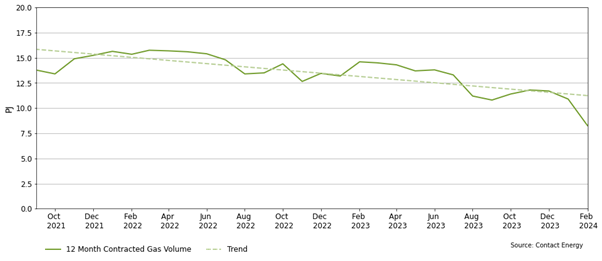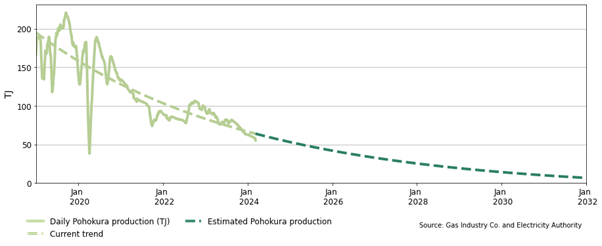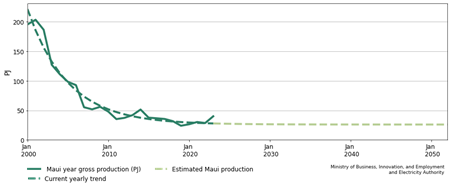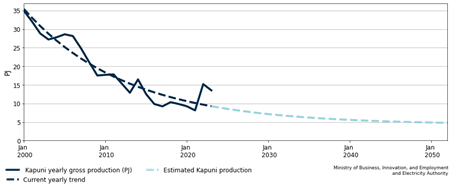Eye on electricity
Natural gas and the electricity sector transition
- Generation
Electricity in New Zealand is supplied by hydro dams, wind farms, geothermal power stations, a few solar farms and thermal power stations – with some using natural gas as fuel.
The New Zealand Government is working towards a renewable energy future and fossil fuels are being phased out, including in the electricity sector. This article discusses the current and future use of natural gas in New Zealand’s electricity system.
Gas currently helps ensure security of supply, especially in winter
Natural gas is produced in Taranaki. The six largest natural gas fields are the three offshore fields, Pohokura, Māui and Kupe, and three onshore fields, Mangahewa, Tūrangi and Kapuni. There are also 12 smaller onshore fields.
The largest user of natural gas in New Zealand is Methanex, which produces methanol. The electricity system is the second largest user of natural gas. Currently 23%1 of New Zealand’s electricity generation can be powered by natural gas, and it’s an important part in ensuring security of supply.
The electricity sector typically uses the most gas in winter when electricity demand is highest. Several gas-fired units can quickly turn on to address supply shortfalls. The average winter2 gas consumption3 used for electricity production between 2018 and 2024 was 105TJ/day.
Large industrial gas users typically have contracts with gas suppliers, which specify a quantity of gas to be delivered at a certain price over a particular time. However, for some, the amount of contracted gas is declining, as companies begin transitioning away from fossil fuels. For example, Contact Energy’s contracted gas volumes for the 12 months ahead have trended down since September 2021.

Gas production is declining
Several New Zealand gas fields are naturally declining as their fuel depletes, including Pohokura, Māui and Kapuni. Without new drilling, these fields may continue to produce less gas in the future.
Using an exponential decay equation fitted to production data, it is estimated that Pohokura’s production may fall to zero TJ during 2026 (Figure 2). The Māui field produced 85% less gas from 2000 to 2024 (with around 200 PJ per year in 2000 to less than 30 PJ in 2024, see Figure 3). Similarly, Kapuni produced about 55% less gas from 2000 to 2024 (with 35 PJ in 2000 and around 15 PJ in 2024), and may fall to less than 5PJ in the 2040s (Figure 4).
Some thermal power plants are set to retire or switch to green fuels
While not all gas fields are in such obvious decline, it is likely that natural gas production will fall over time without further drilling or investment. The impact on the electricity sector is likely to be offset by thermal power stations retiring or switching to biofuel and more renewable generation (solar and wind farms) being built. For example:
- Contact Energy’s largest thermal unit, TCC, will retire in 20254
- Genesis Energy are investigating the viability of biomass to power its Rankines
- Contact Energy’s Tauhara 174MW geothermal power opened in November 2024
- Meridian completed commissioning for its 176MW Harapaki wind farm in July 2024
- There are currently 5 solar farms injecting to the grid with more in the pipeline
- Grid-scale batteries will maximise the benefits of renewable energy and provide extra resilience during times of tight electricity supply.
Gas will continue to play an important role in security of supply as New Zealand transitions to net zero carbon emissions. Currently, gas supports our electricity system during periods of high demand, such as evening peaks and when hydro storage is low. However, the role of gas in New Zealand’s future electricity system will change, given the:
- retirement of some thermal power plants
- interest in biofuels
- extensive renewable generation build pipeline
- expected continued decline in gas production
In the short to medium term, gas fired peakers may be used to cover peak demand periods, but in the longer term this will likely decrease, especially as the system utilises more demand response.
Helping the industry adjust
The New Zealand electricity system may face challenges as it transitions to more renewables and away from thermal fuels like gas. The Electricity Authority Te Mana Hiko will continue to support the industry with this transition.
The Authority is working to enable more demand-side response so organisations and individuals can take more control over their energy use. This will help smooth out the peak periods, which are currently largely supported by gas.
Information is critical to operating the electricity system. The Authority is working with Transpower and the Gas Industry Company to ensure market information, such as gas contract positions and energy risk, is reported accurately and credibly, so there is an accurate picture of the immediate risks that need to be managed.
The Authority has put in place coordination measures and better management of supply risks for high demand winter periods and is working on a strategic pathway for 2025 and beyond to support security of supply through the transition to electrification.
A colder than usual Autumn and low inflows through Winter 2024 put some pressure on fuel supply with gas uncertainty and declining hydro storage leading to price rises in the spot market. Winter 2025 may still see some high prices on the spot market due to higher thermal commitment as we wait for the key hydro catchments to receive some significant inflows.
The Authority is also implementing the advice of its Market Development Advisory Group (delivered in December 2023) to improve the wholesale market to ensure electricity is clean, reliable and available at the lowest possible cost.



1. Some thermal units can also run on coal.
2. June-August only.
3. Excluding gas from Ahuroa gas storage facility.
4. Its retirement is dependent on how many future hours it runs.
Related News
Centralised wind and solar forecaster contract awarded
The Electricity Authority has awarded a contract to provide centralised wind and solar forecasting services to DNV Services.
Battery energy storage systems roadmap released
We have published a draft two-year roadmap that sets out our work to support investment in battery energy storage systems (BESS). BESS will become increasingly…
Submissions published on frequency-related Code amendment proposals
We have published submissions on our proposal to amend Part 8 of the Code to address increased frequency variability in New Zealand’s power system.